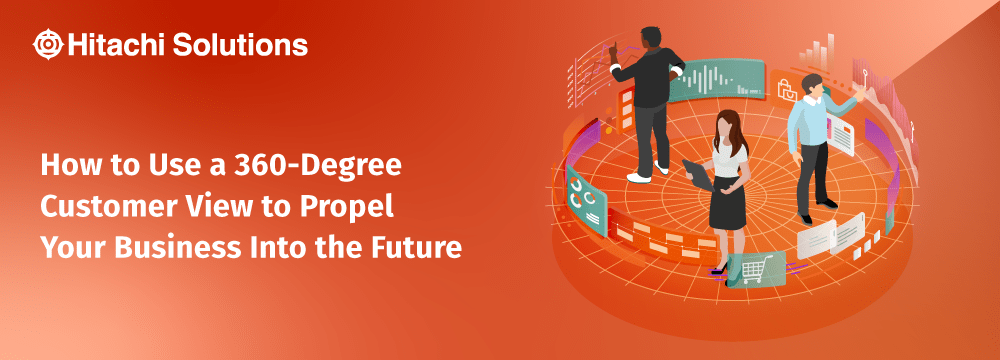

The Journey to High-performance Customer Service
Download our eBook to dive into customer service in retail and CPG industries.
Download the EbookBusinesses across all industries are looking to get a competitive edge, and they know that the key lies in providing the best customer experience possible. Customers in the 21st century have high expectations, as their options are endless and their needs and wants can be met instantaneously through digital technology. So how can organizations gain insights into their target demographics and cater to every customer demand?
By having a full and comprehensive understanding of customer trends and behavior across every possible channel of interaction.
This invaluable 360-degree view of each customer — customer 360 for short — enables businesses to leverage data and analytics to make smarter, data-driven business decisions. According to CMS Wire, “aggregating all this data to build an accurate 360-degree view of customers is only possible with data management tools that capture data from all systems and channels, and match, merge and enrich it to create the complete customer profile, correlated to their omnichannel interactions and transactions.”
But what exactly is customer 360 and how can you put it into action?
What is Customer 360?
According to TechTarget, customer 360 is “the idea that companies can get a complete view of customers by aggregating data from the various touch points that a customer may use to contact a company to purchase products and receive service and support.” The 360-customer view paints a complete picture by showing past, present, and future data.
In today’s digital ecosystem, the number of touchpoints that connect a business with their customers has multiplied drastically. Across online, in-person, social media, and mobile apps, customers are constantly interacting with brands and others in the same industry — all of which leaves a trail that can be leveraged by businesses for enhanced customer insights.
A modern 360 customer view is about taking an omnichannel approach to all the data and information in a customer profile and using artificial intelligence (AI) and analytics systems to inform customer service, user experience, and overall operations. When done correctly, customer 360 can lead to improved business outcomes, increased productivity, and — most importantly — revenue generation.
What Does a 360° Customer View Show?
The continued development of new digital touchpoints, such as new social media apps and the Internet of Things (IoT), has given businesses access to more customer information than they know what to do with. And customers are generating more and more data every second, which gives businesses the customer 360 degree view they need to develop personalized customer profiles that can be updated in real time. To fully understand what customer 360 is and just how impactful it can be, it’s best to understand just some of the metrics that can be collected and utilized:
Customer demographics
- Personal History – name, age, address, contact information, occupation, place of employment, etc.
- Family information – children, partners, anniversaries
- Public information – regional demographics, insolvency records
Product/service activity
- Store information – preferred store, frequent purchases
- Behaviors – purchase triggers, purchase trends
- Product history – views, reviews, returns
Interaction history across channels
- Social media – all social platforms, posts, likes, shares
- Customer service – call centers, chat bots, emails
- Physical space – In-store personnel, brick-and-mortar locations
Marketing intel
- Lifetime sales, predicted lifetime value, average transaction, etc.
- Effectiveness of campaigns, changes in behavior
Individually, these different points of interaction allow for more opportunities for your customer to connect with your organization. When connected into a centralized system, individual channels become an omnichannel view, providing a larger context for a customer’s every interaction with your business.
Benefits of a 360° Customer View
The goal of a leveraging a single customer view is ultimately to drive revenue, but there are numerous benefits businesses can expect along the way. Here are just some of the benefits companies across industries can expect from 360 customer view.
- your customers and their behaviors better
Businesses can use a comprehensive customer relationship management platform (CRM) to build a holistic customer profile and optimize customer engagement. CRMs capture all relevant customer data and help businesses turn it into an actionable profile. Once customers have a robust profile, businesses can collect even more data from customer interactions, such as customer churn, segmentation, and product churn. - Leverage customer and sales insights in marketing
Using these same customer 360-powered solutions, businesses can build tailored marketing campaigns based on recent and real-time customer and sales insights. As data and feedback is collected on all sales and marketing initiatives, businesses can then create a campaign performance dashboard that allows them to see how campaigns landed with different stores/customer segments, and then make improvements. - Reduce overall costs
By making more data-driven decisions about some of the more costly business functions — marketing, sales initiatives, product lines, and more — businesses can maximize these aforementioned functions effectively and reduce overall costs. Customer 360 insights allow for more intelligent strategies, such as better targeted and segmented customer groups. By using concrete data to be more intentional, expect to see an overall improvement on the return on investment across operations. - Create more personalized experiences
With an enhanced understanding of consumer behavior and preferences, businesses can be more effective and targeted in everything they do. They can create content, roll out new products, and provide services that are intentionally targeted and tailored to their customer base. This pays dividends in the long run; 80% of customers are more likely to purchase a product or service from a brand that provides personalized experiences, according to an Epsilon study. - Drive customer loyalty
Ultimately, a single customer view empowers businesses to optimize customer engagement. This translates into improved customer interaction and customer experiences, which ultimately results in a greater lifetime value. Customers are more apt to continually buy from brands that consistently meet or exceed their needs. According to The Wise Marketer, 56% of customers say they will stay loyal to brands which “get them.”
The Impact of Customer 360° Across Industries
Insurance: For insurance organizations, a 360-degree view of the policyholder, member, or broker empowers team members to serve the appropriate audience with the right information at the right time and resolve service requests quickly.
Manufacturing: With a 360-degree view of their customers, manufacturers gain new insights that enable their workforce to identify and focus on the products they sell and service the most. Insights can be used to design personalized customer portals, allowing for more direct input from customers, creating more efficient production, and enabling an overall better experience across all customer touchpoints.
Retail: Having a complete view of the customer enables retailers to provide highly targeted and personalized customer experiences which drive higher customer loyalty, richer product recommendations, and provides the ability for market basket analysis. The merchandising and brand teams can also leverage customer information to continue to refine segmentation, product development, placement, and brand awareness.
Financial Services: A 360-degree view of a clients’ household, assets, loans, and other products across lines of business allows financial services firms to provide more tailored service and offerings. It has been proven, time and time again, that when customers receive customized product offerings or personalized service, they are more apt to return, remain loyal, and even become advocates for your business.
Tools to Develop a 360° Customer View
The most challenging aspect of 360 customer programs is that today’s amount of generated data is astronomical. A TechTarget article put it best: “With the advent of technologies such as mobile devices, video customer support, online communities, social media platforms, and more, the various touch points with which customers may interact has proliferated, which can make the task of aggregating the data from these various interactions more difficult to achieve.”
To be able to utilize data to create a 360-degree customer view, businesses must first ensure that all data is consolidated and accessible by one data analytics system. Modern data analytics allows for the collection of limitless amounts of data across multiple channels. Advances in machine learning AIs, now often supported by immensely powerful cloud-based systems, allow for more accurate predictive analytics for insights into future customer actions and possible trends.
Years ago, it was commonplace to have disparate systems, but siloed data means inaccurate insights and an incomplete view of customer engagement. Today’s digital platforms, such as Microsoft Dynamics 365, allow for seamless connections between Sales, Marketing, and Service CRM systems for a unified and coordinated understanding of customers across all departments. Now, with one complete data system that is aggregating as well as analyzing collected data, businesses can then deploy digital solutions — data analytics, predictive analytics, machine learning AIs, CRMs, and custom applications — to build a holistic customer profile that enables a true customer 360 view.

These customer 360-powered solutions can then create a campaign performance dashboard that allows businesses to generate differentiated experiences unique for each customer and customer interaction. In addition to the aforementioned solutions, some additional customer 360 tools to consider include:
- Social media listening tools – listening tools, such as Hootsuite, allow businesses to go beyond the initial data of likes, comments, and interactions. With these technologies, they can see what customers are saying on social media and gain enhanced insight into ad campaigns, reputation management, and more.
- Sales and marketing automation software – using the in-depth customer insights leveraged from customer 360 initiatives, businesses can create more tailored sales and marketing programs. One method, automated emails, has a markable ROI for businesses who take the time to invest in this personalized content. ActiveTrail reports that personalized emails result in:
- 27% higher clickthrough rates
- 11% higher open rates
- 6 times higher transactional rates
- A median ROI of 122%
Why Hitachi Solutions?
Implementing a 360-degree customer view starts with a deep understanding of your current capabilities. From there you can start the process of conceptualizing a customer experience that will be consistent across channels, will cater to your customers’ preferences, and will utilize your intelligent analytics platform and robust CRM system to effectively leverage customer data.
At Hitachi Solutions, we’re proud of our years of experience working with companies across different industry to develop a customer-centric design that’s actionable across their entire enterprise. Our proven expertise in helping businesses achieve successful technology transformations has earned us more than 40 Microsoft Partner of the Year awards.
Rather than being a one-time partner, our goal is to assist you in developing scalable solutions that will continue to work for you years into the future. Review our Digital Compass solutions guide to see how you can get started on your digital transformation – for more information on customer 360, we suggest the Differentiated Experiences track and the Unified Operations track.
If you are ready to start putting your customer data to good use, contact our team today.


